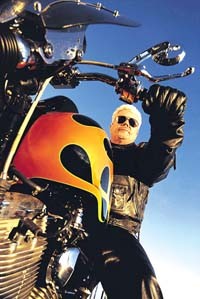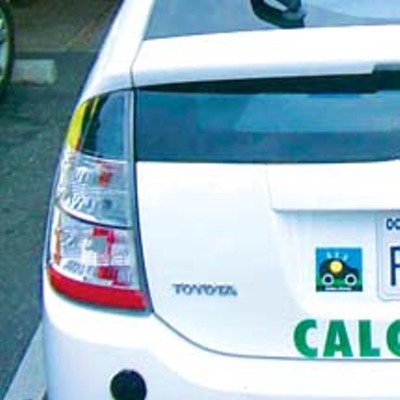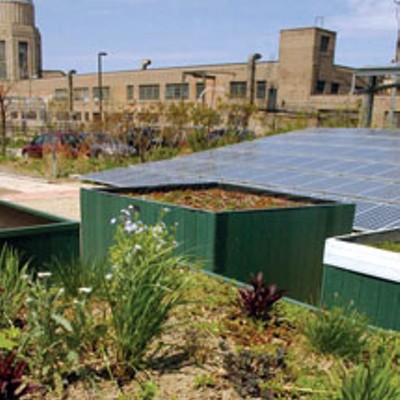Bad to the bone
Motorcycles are tough on the environment

PHOTO COURTESY OF GETTY IMAGES
Motorcycles are tough on the environment, spewing as much as 15 times more pollution per mile than do cars and light trucks.
[
{
"name": "Air - MedRect Combo - Inline Content 1",
"component": "11490391",
"insertPoint": "3",
"requiredCountToDisplay": "1",
"parentWrapperClass": "fdn-ads-inline-content-block"
},{
"name": "Air - MedRect Combo - Inline Content 2",
"component": "11490392",
"insertPoint": "7",
"requiredCountToDisplay": "5",
"parentWrapperClass": "fdn-ads-inline-content-block"
},{
"name": "Air - MedRect Combo - Inline Content 3",
"component": "11490393",
"insertPoint": "12",
"requiredCountToDisplay": "9",
"parentWrapperClass": "fdn-ads-inline-content-block"
}
]
Untitled Document
How much pollution do motorcycles generate? Are there
efforts to make them more eco-friendly?
Motorcycles typically get about double the gas mileage of even the most fuel-efficient cars, but that doesn’t mean that they’re green. Despite getting 60 to 70 miles per gallon, motorcycles are not subject to the same rigorous emissions standards as cars and light-duty trucks, even though they spew as much as 15 times more pollution per mile, mostly in the form of smog-causing hydrocarbons and nitrogen oxides. Increasingly stringent regulations in Europe and the United States have forced automakers to make their engines cleaner, but motorcycle manufacturers have not been held to such high standards and have therefore been slow to implement similar advances. According to the European Commission, motorcycles — despite only accounting for about 3 percent of total traffic volume in Europe — are expected to generate as much as 14 percent of that continent’s total hydrocarbon emissions by 2010. But there is light at the end of the tunnel, thanks in large part to the state of California, which in 2004 passed legislation to green up motorcycles sold and ridden in that state. California’s new standards dictate that hydrocarbon and nitrogen oxide emissions from motorcycles must top out at only 0.8 grams per kilometer, down from 1975-set standards of between 5.0 and 14.0 g/km (depending on engine size). And in 2005 the United Nations’ World Forum for Harmonization of Vehicle Regulations, which works internationally to set vehicle-emissions standards, issued a new set of motorcycle-emissions-testing guidelines that will make it easier for manufacturers to design more green-friendly motorcycles.
In the wake of these developments, the U.S. Environmental Protection Agency established new federal rules that require motorcycle makers to reduce their products’ emissions by 50 percent. In place since the beginning of the 2006 model year, these new rules are expected to cut combined hydrocarbon and nitrogen oxide emissions from motorcycles by about 54,000 tons a year while also saving approximately 12 million gallons of fuel annually by preventing it from escaping from fuel hoses and fuel tanks.
Many manufacturers are rising to the challenge. Honda, already a world leader in the development of greener cars, is putting the finishing touches on its new “idling-stop system” that cuts fuel consumption and exhaust emissions by turning off the engine instead of idling at stop lights and in traffic jams. And Intelligent Energy, a British company, is developing an Emissions Neutral Vehicle, a motorcycle powered by a detachable hydrogen-powered fuel cell. The vehicle can reach speeds topping 50 mph while making virtually no noise and can run for as long as four hours without being refueled. Bigger, faster, and longer-running versions of the ENV are currently in the works and should become widely available in Europe, the United States, and elsewhere within a few years.
For more information: California’s “New Standards for On-Road Motorcycles,” www.arb.ca.gov/msprog/motcycle/onrdmc.htm; EPA’s Motorcycle Emissions Info, www.epa.gov/otaq/roadbike.htm; Intelligent Energy, www.intelligent-energy.com; Honda Motorcycles,powersports.honda.com/ the_story/environment.
Send questions to Earth Talk, care of E/The Environmental Magazine, P.O. Box 5098, Westport, CT 06881 or e-mail [email protected].
Motorcycles typically get about double the gas mileage of even the most fuel-efficient cars, but that doesn’t mean that they’re green. Despite getting 60 to 70 miles per gallon, motorcycles are not subject to the same rigorous emissions standards as cars and light-duty trucks, even though they spew as much as 15 times more pollution per mile, mostly in the form of smog-causing hydrocarbons and nitrogen oxides. Increasingly stringent regulations in Europe and the United States have forced automakers to make their engines cleaner, but motorcycle manufacturers have not been held to such high standards and have therefore been slow to implement similar advances. According to the European Commission, motorcycles — despite only accounting for about 3 percent of total traffic volume in Europe — are expected to generate as much as 14 percent of that continent’s total hydrocarbon emissions by 2010. But there is light at the end of the tunnel, thanks in large part to the state of California, which in 2004 passed legislation to green up motorcycles sold and ridden in that state. California’s new standards dictate that hydrocarbon and nitrogen oxide emissions from motorcycles must top out at only 0.8 grams per kilometer, down from 1975-set standards of between 5.0 and 14.0 g/km (depending on engine size). And in 2005 the United Nations’ World Forum for Harmonization of Vehicle Regulations, which works internationally to set vehicle-emissions standards, issued a new set of motorcycle-emissions-testing guidelines that will make it easier for manufacturers to design more green-friendly motorcycles.
In the wake of these developments, the U.S. Environmental Protection Agency established new federal rules that require motorcycle makers to reduce their products’ emissions by 50 percent. In place since the beginning of the 2006 model year, these new rules are expected to cut combined hydrocarbon and nitrogen oxide emissions from motorcycles by about 54,000 tons a year while also saving approximately 12 million gallons of fuel annually by preventing it from escaping from fuel hoses and fuel tanks.
Many manufacturers are rising to the challenge. Honda, already a world leader in the development of greener cars, is putting the finishing touches on its new “idling-stop system” that cuts fuel consumption and exhaust emissions by turning off the engine instead of idling at stop lights and in traffic jams. And Intelligent Energy, a British company, is developing an Emissions Neutral Vehicle, a motorcycle powered by a detachable hydrogen-powered fuel cell. The vehicle can reach speeds topping 50 mph while making virtually no noise and can run for as long as four hours without being refueled. Bigger, faster, and longer-running versions of the ENV are currently in the works and should become widely available in Europe, the United States, and elsewhere within a few years.
For more information: California’s “New Standards for On-Road Motorcycles,” www.arb.ca.gov/msprog/motcycle/onrdmc.htm; EPA’s Motorcycle Emissions Info, www.epa.gov/otaq/roadbike.htm; Intelligent Energy, www.intelligent-energy.com; Honda Motorcycles,powersports.honda.com/ the_story/environment.
Send questions to Earth Talk, care of E/The Environmental Magazine, P.O. Box 5098, Westport, CT 06881 or e-mail [email protected].
Illinois Times has provided readers with independent journalism for almost 50 years, from news and politics to arts and culture.
Your support will help cover the costs of editorial content published each week. Without local news organizations, we would be less informed about the issues that affect our community..
Got something to say?
Send a letter to the editor and we'll publish your feedback in print!



















